In this guest blog, Keith Harrison-Broninski FRSA, lead of the RSA Catalyst project Town Digital Hub, looks at how the RSA Heritage Index relates to the emerging concept of a Living Asset Map, and how heritage is all about people.
Let’s start by asking what is meant by community asset mapping. Here is the description in a toolkit from Kent County Council’s Public Health Department:
Community Mapping (sometimes called asset mapping) is all about involving residents in identifying the assets of their neighbourhood, looking at opportunities and creating a picture of what it is like to live there. Every community has assets; facilities such and libraries and community centres, valued businesses, parks are obvious. But most importantly the people and their capacities; organised community groups or individuals who have skills and talents. All of these things can be mapped to create a picture of the community which shows its capacity and potential. Community mapping can encourage people become powerful advocates for the transformation of the spaces in which they live, becoming more civically minded in the process. It can also foster a sense of environmental and community responsibility in local residents.
An interesting aspect of this toolkit is the email address supplied for further enquiries: mentalwellbeing@kent.gov.uk. Kent County Council is clearly aware of the close connection between mental health and a strong sense of community, a connection that stems from a transformational concept in psychology that emerged at the end of the twentieth century: “positive psychological capital” or PsyCap. Often used as a means of assessing fit between employees and job roles in large organisations, PsyCap originated in an attempt to move away from psychology's historical emphasis on mental illness and towards the original but forgotten goals of the discipline:
- Help ordinary people to live a more productive and meaningful life.
- A full realization of the potential that exists in the human being.
PsyCap is defined in terms of four inter-related characteristics: hope, self-efficacy, optimism, and resiliency. Hope is about identifying goals and planning to reach them, while self-efficacy is about believing you can achieve them. Optimism is about seeing bad events as exceptional, and resiliency is about recovering from them. In relation to public health, wellbeing professionals are increasingly coming to understand that helping people to become “healthy” is not so much about getting them to eat better and exercise more, but rather about enabling them to identify and achieve their own personal outcomes generally – in other words, it is about helping them develop PsyCap.
This insight leads naturally to a focus on strong sense of community, for a simple reason –most people feel more hopeful, efficacious, optimistic and resilient if they have a support network around them. Yet in the 21st century, communities everywhere struggle to maintain a sense of togetherness in the face of constant social and technological change. For this reason, Kent County Council describes considers the “most important” assets of the community to be not physical places or objects but rather “organised community groups or individuals who have skills and talents”.
A similar emphasis on people is found in another description of Community Mapping, from the Sustainable Communities North East Initiative (a partnership set up to secure a more sustainable future for the North East’s communities), which identifies 5 steps for creating a map, concluding with:
5. Draw a picture showing the assets of the agencies including the services they offer, the physical spaces and funding they could provide, and the staff and networks they have. Depending on the local vision, extend the maps to include physical, economic and cultural assets.
Here “physical, economic and cultural” assets are not even considered essential for inclusion in the map – in other words, the core assets of a community are assumed to be local people and organisations, and the services they offer, since it is these assets that are most critical in helping people identify and achieve personal outcomes. However, this brings an inherent difficulty - a community asset map is traditionally created as a static picture, but people and organisations are a moving target. Treating them as static not only reduces the effectiveness of assets in increasing wellbeing, but also for other purposes such as economic regeneration.
So a new approach is emerging, that of a “Living Asset Map” - a dynamic artefact that is updated and owned by the assets themselves if possible and certainly by the local community as a whole. It is not practical to represent such a changeable artefact as a picture, since the effort required to maintain the visual layout is so high. In order to find a better representation, it is necessary to focus on its core purpose, i.e., to develop PsyCap, which is all about personal goals. A Living Asset Map is essentially a way of connecting personal goals to relevant community assets, in such a way that both can be updated as and when necessary. This is exactly the purpose of Town Digital Hub.
Local organisations (public sector, third sector and other) use their digital hub to agree what resources they can contribute to help the public meet their personal goals, using tools provided to work together on reducing gaps/overlaps and increasing synergies. The public can then choose an issue and a related personal goal to see what is available to them, and click through on items of interest to see details, as shown below.
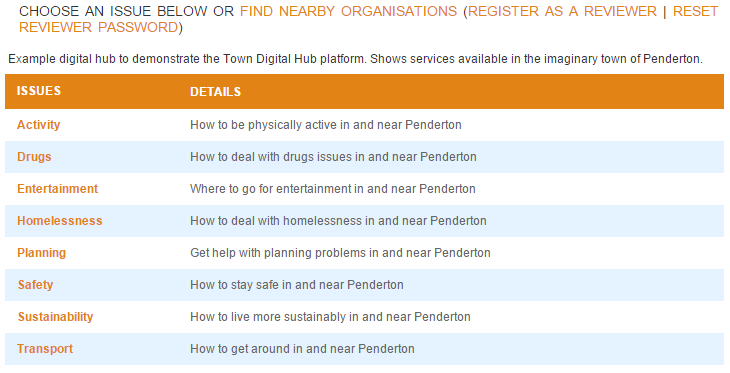
Figure 1: Choose an Issue in Town Digital Hub
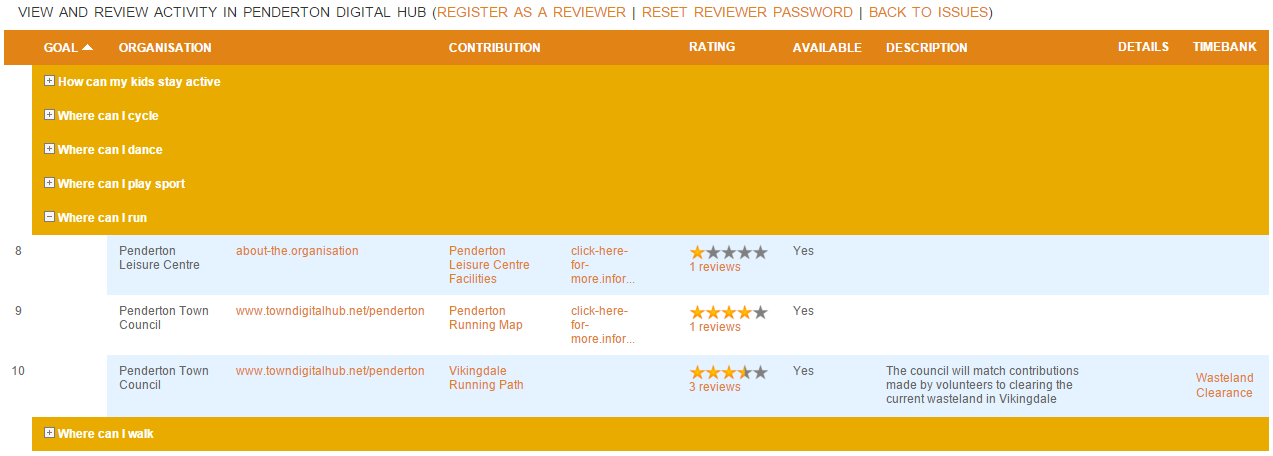
Figure 2: Choose a personal Goal in Town Digital Hub
Critically, the public can also leave ratings and reviews in the same way as TripAdvisor, to give providers direct feedback that helps them improve their offerings, as shown below. This highly targeted feedback, normally expensive and difficult to obtain, not only comes at zero cost but also enables providers to evolve and improve their services continually. Since they then use the digital hub to record these changes, it acts as a Living Asset Map, owned and maintained by the community itself.
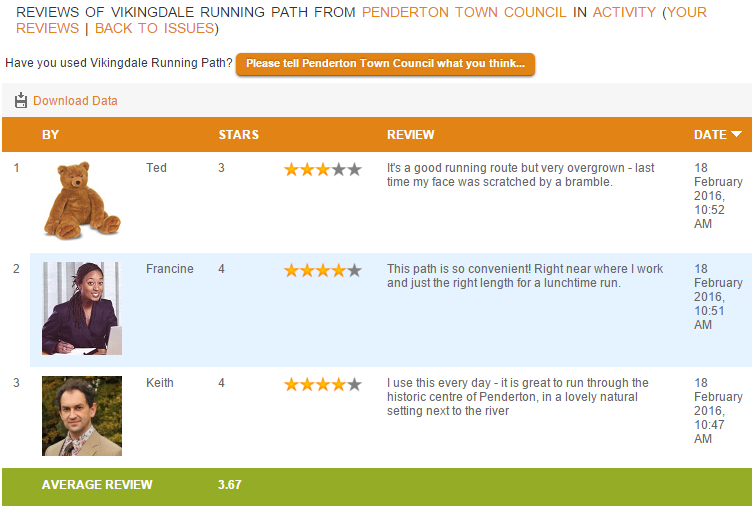
Figure 3: Reviews in Town Digital Hub
So how does this relate to the RSA's project on Heritage, Identity and Place? The Index helps communities understand local heritage assets and activities, so as to gain more value from these assets - to stimulate debate about what is valued from the past, and how that influences the identity of its current residents, in order to help a place achieve its aspirations to grow and prosper, socially and economically. In other words, identifying heritage assets is not an end in itself, but rather a means to help the community move towards goals. In the example above, an unused riverside path becomes a free, enjoyable way for the population to stay active.
The RSA Heritage Index is not about places and things but rather about how people use them – and for it to deliver the intended value, it must be used in Living Asset Maps showing the developing usage of heritage assets to achieve community goals, via a tool such as Town Digital Hub. Only then will heritage assets achieve their potential as a means of developing local PsyCap, with the consequent benefits to wellbeing and regeneration.
Related articles
-
A Community finds its voice: One Heritage Ambassador's Story
jc
June Campbell FRSA and Heritage Ambassador reflects on what is required to cherish and develop a sense of place where you live with a reflection on the Anstice Memorial Hall in Madeley.
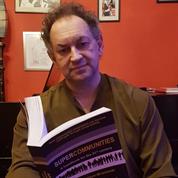
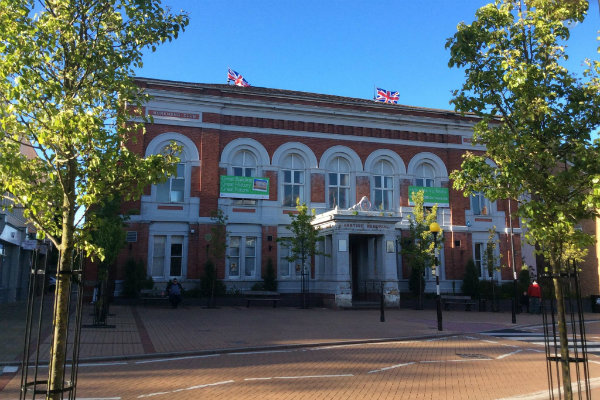
Be the first to write a comment
Comments
Please login to post a comment or reply
Don't have an account? Click here to register.